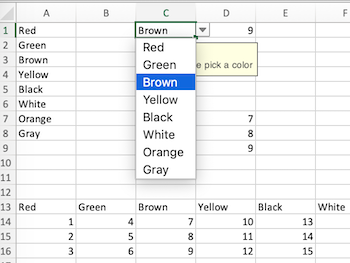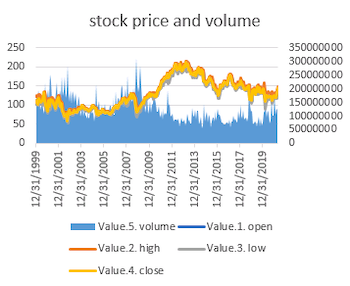Microsoft Excel provides keyboard shortcuts to most frequently used functions and memorizing them is one of the best ways to boost productivity in Excel. There are multiple strategies to remember them and various people use different ways to learn them efficiently:
- Print them and put a hard copy next to the monitor
- Collect them in small batches and put them post-it notes
- Use Excel specific keyboard stickers
Either way, the best way to learn them is to keep practicing and repeating them until they turn into muscle memory.
The shortcuts below work for both Mac and PC, however, sometimes “Cmd” should be used instead of “Ctrl”, we’ll mark those separately.
Navigation
It’s possible to switch between worksheets, Excel windows, quickly jump to the beginning or the end of a row, column or document by using these shortcuts. As a rule of thumb, pressing Shift with a shortcut adds “selection” mode to it, just like Shift + Arrows move the cell selection with the cursor.
Ctrl (Cmd) + Arrows – Jump to the edge of the current data region in the direction of the arrows. Excel will find the last non-empty row or column and jump there. Repeating it jumps to the next region or the beginning / end of the workbook if there are no more non-empty cells available.
Ctrl + Shift + Arrows – Similar to Ctrl + Arrows, jump to the edge of the current data region and select cells at the same time. Ctrl + Shift + Right, Ctrl + Shift + Down is a quick way to select a complete data range, starting from the top leftmost cell.
Ctrl + Shift + End – Extend selection to the bottom rightmost cell from the current one. It will include all continuous data ranges, so all the cells to the bottom right from the cursor will be selected.
Ctrl + Home – Jump to the beginning of the active worksheet.
Ctrl + Shift + Home – Extend selection from the current cell to the beginning (top leftmost) part of the worksheet
Ctrl (Cmd) + PageUp / PageDown – Jump to the next / previous worksheet.
Ctrl (Cmd) + Z – Undo the last action – this can be done repeatedly
Ctrl (Cmd) + Y – Redo – reverse the last Undo step, repeat the action that was just undone
Ctrl + Shift + * – Select the whole continuous active region (cells with data in them) around the currently selected cell
Ctrl + Space – Select an entire column in a worksheet including empty cells. If multiple rows are selected, it will select all the columns in all the selected rows.
Shift + Space – Select an entire row including empty cells. Similar to the one above, selecting a few cells in a column then pressing Shift + Space will select rows to include all the cells that are already selected.
Ctrl (Cmd) + A – Select the whole workbook
Formatting
Some of the simple functionality to format text in a cell can be accessed directly by using keyboard shortcuts, others require opening the formatting dialog. By default, these shortcuts work on the whole cell but it’s also possible to format parts of a cell differently by selecting it first then applying formatting functions to it.
Ctrl (Cmd) + B or U or I – Apply or remove bold / underline / italic from the selected cell or range of cells.
Ctrl (Cmd) + 1 – Open the formatting dialog.
Ctrl + Shirt + ~ – Format the current cell as a general number.
Ctrl + Shirt + $ – Format the current cell as currency.
Ctrl + Shirt + % – Format the current cell as a percentage style number. Percentage style numbers are based on fractions, so having “0.4” there will display 40%.
Ctrl + Shift + @ – Day and time format, similar to “2021-01-01 03:40” or whatever the regional setting is set to by default.
Ctrl (Cmd) + 0 – Hide all the columns that are currently selected.
Ctrl (Cmd) + 9 – Hide all the rows that are currently selected.
Ctrl (Cmd) + Alt + V – Paste special dialog – useful when pasting random formatted text to get rid of the original formatting.
Frequently used
These shortcuts work in all office apps (and most other apps for that matter) so they should already be familiar
Ctrl (Cmd) + W – Close the active workbook, it will ask to save if there are unsaved changes.
Ctrl (Cmd) + S – Save the active workbook.
Ctrl (Cmd) + O or Ctrl (Cmd) + F12 – Open a new workbook.
Ctrl (Cmd) + P – Print active workbook.
Ctrl + H – Search and Replace. Quick and easy access to replace text in a workbook or a range of selected cells.
Excel specific advanced shortcuts
These shortcuts provide quick access to most of the frequently used tools and they should really boost productivity.
Ctrl (Cmd) + ` – Display formulas. Activating this will replace all the calculated cells with the formula they contain on-screen so they display formulas instead of their result. Using it again will quickly turn it off.
Ctrl (Cmd) + K – Insert hyperlink. After selecting a cell, activating this shortcut will open a dialog where a URL can be added. It will turn the cell into a link that points to the URL previously set.
Ctrl + Shift + _ – Remove all the outline borders from the selected cell(s).
Ctrl + Shift + 7 – Apply an outline border to the selected cell(s).
Ctrl + Shift + “ – Copy the value or formula of the cell above the current one into the current cell or formula bar.
Ctrl (Cmd) + D – Copy the formula or value from the cell above (copy “down”). Selecting a whole range of cells before activation will fill it all with the top value.
Ctrl (Cmd) + R – Copy the formula or value from the cell to the left (copy “right”). Works similarly to Ctrl+D, select a column of cells and it will fill it with the value in the leftmost cell.
Ctrl + Enter – After selecting a range of cells then entering a value, pressing Ctrl + Enter automatically fills all the cells with the same value
F2 or Ctrl (Cmd) + U – Edit the current cell in the formula bar.
Ctrl + Shift + U – Expand the formula bar, it is useful to edit a complicated formula or multi-line data. Activate again to collapse it
Ctrl + ; – Insert current date into the active cell
Ctrl (Cmd) + T – Convert a range of cells into a Table.


